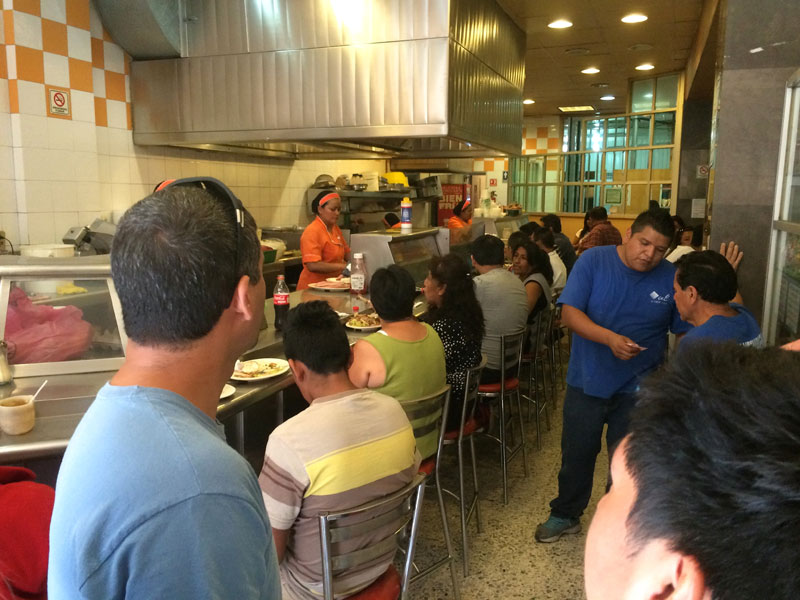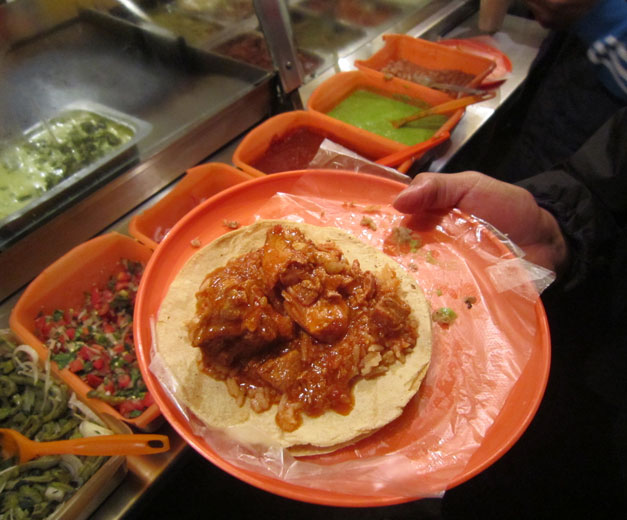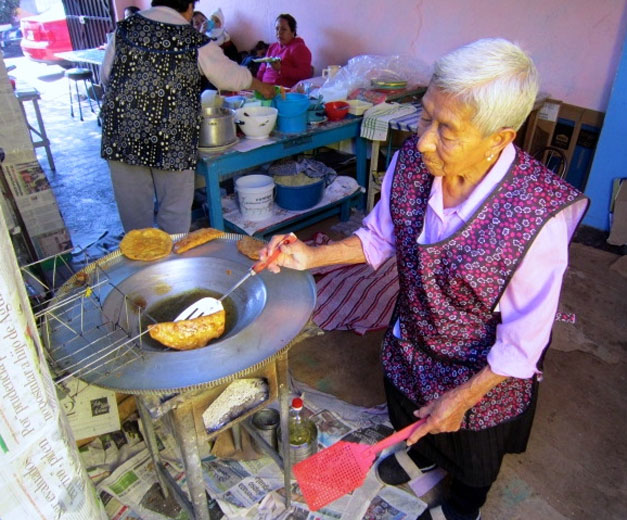We can't find the internet
Attempting to reconnect
Something went wrong!
Hang in there while we get back on track
Search results for "James Young"
Mexico City
La Faena: Union Made
From the point in 2002 when multibillionaire Carlos Slim inked a deal with Mexico City to revitalize its historic center until now, there have been layers of change. Streets were made pedestrian-only after months of work by bulldozers and jackhammers. Broken windows and abandoned buildings have been replaced with countless new shop fronts offering shiny opportunities. Despite the strictures of tough legal bulwarks against eviction, a Giuliani-esque wave of economic empowerment has swept the city’s center, spray-brushing away signs of endemic poverty in ironic lockstep with scheduled protests by social-justice movements ranked by those who casually grab a bite after the march. Crowds are swelling along the planned corridors.
Read moreMexico City
Kebab Nation: Spit-roasted Fusion
At Culinary Backstreets, we tend to opt for tradition over trendy, street over chic. We delve into a city’s blind spots when it comes to local favorites. Taking that approach makes it too easy to dismiss new spots out of hand. So, if it weren’t for our friend Liz hounding us for months about a newish “falafel place” near her house, we almost certainly would not have thought about visiting it. But that’s the great thing about friends – they take us out of our routine and generally bring us to unexpected places, as was the case with Kebab Nation.
Read moreMexico City
Don Lázaro El Viajero: Lunch School
In the tale of Don Lázaro El Viajero, a Spanish Jew named Lázaro L. Torra, escaping the fascist advance in that nation’s civil war, fled in 1939 to Mexico City – one of tens of thousands that then-President Lázaro Cárdenas invited to find refuge in Mexico amid the black conflict of that war. By 1944 Torra had become something of a restaurateur/maestro, teaching kids in a kinda-working-class, kinda-middle-class neighborhood to speak in English and improve their Spanish and feeding them some decent grub in the same go. (The name of the restaurant, Mr. Lazarus the Traveler, has to do with its proximity to a road heading out of town before the city went all crazy huge and viral.) That was the deal. You got food, but you had to learn something in the process.
Read moreMexico City
Behind Bars: The Ghosts of Drinkers Past at Tío Pepe
For every level of society inside and outside Mexico, cantinas serve as both toxin and tonic for drink, song, jocularity, wit, mayhem and mishap. Tio Pepe, now thought to be the oldest such bar in the old Aztec capital, has provided both in equal measure since way before it received its present name in 1878. The cantina is nowadays a refuge for Mexican politicians, as the nation’s state department and the city’s supreme court sit in front of it. On a Tuesday at noon, we found a huddle of operatives gathered in a booth arguing amid cocktails. We sat down with Don Sebastian Alvarez, who took up bartending at Tío Pepe in 1987, a witness to the ebb and flow of politicians, luminaries and troublemakers passing through the doors.
Read moreMexico City
Sanadoras La Caldería: Slow Soup
We grew up in a household where drinking soup directly from the bowl was frowned upon, done only surreptitiously when Mom was looking away or as an act of impish rebellion, a bold unshackling from the spoon and its torment. Yet it took little prodding from Isis Iturriaga, founder and proprietor of Sanadoras La Caldería, to lift our earthenware bowl with both hands to eager lips and down the last of our impeccable caldo de hongos (mushroom soup) in three great gulps. “You are in your home,” she reiterated as the chipotle-infused liquid began to spark our insides. This is her mantra for the place, a plinth at the core of her being.
Read moreMexico City
Kolobok: From Russia with Love
Located in the picturesque neighborhood of Santa Maria la Ribera, Kolobok – the little Russian restaurant that could – bustles in the Mexico City dusk one recent Sunday afternoon. Patrons cluster around the warm light of the to-go window, shouting out empanada orders over the sound of a band playing nearby in the neighborhood’s Plaza Morisko. Ducking inside, we grab a seat at one of the few, tightly clustered tables, feeling cozy and warm after the chill outside. Russian cuisine remains something of a mystery to most Mexicans as immigration from that country has been a mere trickle in comparison to the various waves of Chinese, Lebanese, Spanish, Argentinean and Korean migrants over the last 200 years, and their resulting culinary contributions.
Read moreMexico City
Antojitos Mexicanos Raquel: A Shot of Vitamina T
The little stall run by Raquel Ángeles and her sister Evi on Balderas Avenue in Mexico City looks like any other of the tens of thousands of stands across the capital that serve millions of people every day. And yet, having eaten at hundreds of these places over the last two decades, we can safely say that the unassuming Antojitos Mexicanos Raquel sits right at the top of our list of go-to spots for a shot of “Vitamina T.” Most Mexicans have to count every peso, and a single hearty meal often has to serve in place of three squares a day, so, borne of necessity, you get “Vitamina T,” a catchall phrase stemming from the preponderance of “T”-named foods.
Read moreMexico City
Jing Teng: More Chino, Less Mexicano
Before we got down to the business of food, there was the business of tea. As soon as we were seated at one of the large round tables at Jing Teng in Mexico City’s Viaducto Piedad neighborhood, our server, Montse, placed a pot of piping hot red tea on the lazy Susan in front of us. As we took our first sip, we noticed the steam billowing out of the kitchen and the chatter of Sunday morning patrons casually conversing in Cantonese in between long stares at a mounted television blasting a cable Chinese news program. An unassuming diner, Jing Teng caters to the community of (somewhat) recently arrived immigrants from China who have settled in the neighborhood.
Read moreMexico City
Taquería Los Parados: No Seats Required
Our trip to Taquería Los Parados in Roma Sur last month began like any other: we gathered up four friends and began the trek to this beloved taco spot. But the dark, moody sky threatened rain, and in anticipation of a gushing downpour, we piled into a cab minutes before the first giant, icy cold rain drops began to pelt down. As was so often the case on July and August evenings in Mexico City, we were at the mercy of the Aztec rain god Tlaloc. Our destination, Los Parados, is one on a short list of taco joints usually shouted at full volume to rally the hungry boozers after a Roma-Condesa bar crawl. On this night, however, it was the taxi itself getting sloshed.
Read moreMexico City
Los Sinaloenses: Fish Cartel
The northwestern Mexican state of Sinaloa is nestled between the western Sierra Madre Mountains and the Gulf of California – putting it between surf and high desert, and the sea doth offer bounty. Be it gigantic squid, run-of-the-mill “fish” or marlin, the sinaloenses fear not the chopping block when it comes to seafood, and the state’s devil-may-care attitude (cooking with lime instead of actual heat) comes full force at Los Sinaloenses, located in trendy Roma Sur. The scrappy refuge lights onto a seafood-based, regional cuisine that manages to stand out in a nation with more than 9,000 km of coastline. It’s characterized by an array of ceviches, cocktails and other arthropod and piscine specialties.
Read moreMexico City
Los Abuelos Empanadas: Earthquake Proof
The neighborhood of San Miguel Chapultepec sits on the west end of Mexico City’s hipster corridor that runs east through Condesa and on to Roma. In the last decade, these neighborhoods have flowered with bars and restaurants fed by tourists and young people eager to impress. The corridor also had the terrible misfortune of being in the crosshairs of the 7.1 magnitude earthquake that struck the city shortly after 1 p.m. on September 19, 2017, toppling familiar buildings and sending all pretense crashing to the floor.
Read moreMexico City
La Miniatura: Small Cakes, Big Business
Julian Ramirez started out at the age of 14 as a shop boy at a busy bakery in Colonia Guerrero in 1959, then a bustling blue-collar neighborhood, easily connected to downtown by streetcar. Back then, at La Antigua del Guerrero, he learned the business: wiping windows, sweeping up and eventually making deliveries on his bike. One nibble at a time, he picked up the art of cake- and bread-making from the shop’s master bakers. Those trade secrets would serve him over the next 63 years and beyond as they pass on to his kids and theirs. Many of Mexico’s classic bakeries like the Guerrero operation fell one by one with the introduction of mass-produced bread, tearing at a staple of communities across the capital.
Read moreMexico City
Best Bites 2016: Mexico City
Mexico is gifted with both a tantalizing array of local delicacies and street stalls beyond count, serving them up for prices designed to feed the masses. It’s paradise for adventurous foodies where the next great meal can be found by simply following one’s nose. Nevertheless, some spots rise to the top, usually building on tradition and a passion for the food itself. Arroces Baby Face In Mexico City, every year brings new discoveries, and I was fortunate in 2016 to discover a gem, parked just out of the way from major tourist footpaths … but only just.
Read moreMexico City
Arroces Baby Face: Heavyweight Plates
Standing on a sidewalk at 9:30 a.m. in Mexico City, waiting for food, one typically imagines pan dulce (sweet bread), tamales and piping hot atole, a drink made from corn. Yet there we stood waiting for Arroz Black Tiger – a steaming, heaping, fried rice dish with salmon, surimi, shrimp and white mushrooms, something you might find for dinner at a trendy Asian fusion restaurant in Roma or Polanco, but certainly not for 135 pesos (US$7.30) and not at that hour. Nevertheless, business was humming, and several clients rushed in and out to place orders for their office, buying early before ingredients start to run out. Why so early?
Read moreMexico City
El Comunitario: The People's Kitchen
We were sitting at the counter, trying out the goods, when an elderly man who has clearly had a tough life copped a squat at the next bench. Leaning on a crutch, with only one eye and a very dinged-up forehead, he patted our shoulder to offer us a cup and a pitcher of fresh, cool water. We chatted a bit. Telling us he’s a regular and praising the preparation of the veggies at El Comunitario, he flashed his toothless, but endearing, smile, “What do you think of how much people are paid here?” It was a genuinely pleasant immersion into the social whirl of this community kitchen, located in one of the more troubled corners in the heart of Mexico City’s Centro. We began to pour water into our other neighbors’ cups and chatted with the cooks in the kitchen, enjoying some great, incredibly cheap grub.
Read moreMexico City
Market Watch: Sugar Rush at Mercado de la Merced
A market with a million stories, the Mercado de la Merced lies sprawling across some 12 blocks in Mexico City, offering a mind-boggling array of goods, as it has for centuries. Operating in the northwest corner, next to the 17th-century Santo Tomás Apóstol La Palma church, is a 67-year-old association of dulcerías – purveyors of sweets and candies – with 154 stalls selling traditional goodies in elaborate and tantalizing displays. Willie Wonka would eat his heart out. According to the association’s president, Daniel Jiménez Chavarría, it is the only market of its kind in Latin America, and it is deeply ingrained in the traditions that thrive across Mexico. “What we sell is purely artisanal, and we are offering a different presentation,” said Jiménez, a silver-haired man with glasses, describing how these small stalls differ from their larger competitors.
Read moreMexico City
Mercado San Juan Arcos de Belén: Produce to the People
Having been divvied up and overshadowed and even having come back from a nasty fire, the Mercado San Juan Arcos de Belén, also known as San Juan Salto del Agua, has hung on tight as a staple market in Mexico City’s downtown. Born from the 1950s-era split-up of the original San Juan marketplace, which stood only a few blocks away in what is now the Plaza San Juan off of Ayuntamiento, this is a very budget-friendly market in Mexico City’s downtown, largely bereft of high-end delicacies but bustling with mostly working-class families. It is shouldered by two major traffic conduits, Eje Central and Arcos de Belén, and sits atop the two-line intersection of Metro Salto del Agua on the forest-green and pink lines.
Read moreMexico City
CB on the Road: Seafood (and Hard Times) in Veracruz
Sitting on the boardwalk of Veracruz, about five or six hours east of Mexico City, we watch the blinking lights of shrimp and fish boats in the farthest distance, knowing our next dinner is on its way. A day before, arriving from the bus, all we wanted was especially satisfying seafood, and the hunt brought us downtown, which, in the past, has always provided. Veracruz is a warm harbor, embracing all comers and proposing excellent food and endless dancing into the night on the city’s street corners. Or that’s how we remembered it.
Read more






















